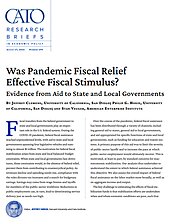Fiscal transfers from the federal government to state and local governments play an important role in the U.S. federal system. During the COVID-19 pandemic, federal fiscal assistance reached unprecedented levels, with aid to state and local governments spanning four legislative vehicles and summing to almost $1 trillion. The motivation for federal fiscal stabilization arises from state and local balanced-budget constraints. When state and local governments face downturns, these constraints would, in the absence of federal relief, prevent them from contributing to countercyclical policy. As revenues decline and spending needs rise, compliance with the rules dictates tax increases and a search for budgetary savings. Savings may come from wage freezes and layoffs for members of the public-sector workforce. Reductions in public employment can, in turn, lead to deteriorating service delivery just as needs run high.
Over the course of the pandemic, federal fiscal assistance has been distributed through a variety of channels, including general aid to states, general aid to local governments, and aid appropriated for specific functions of state and local governments, such as funding for education and transit systems. A primary purpose of this aid was to limit the severity of public-sector layoffs and to increase the pace at which public-sector employment would ultimately recover. This is motivated, at least in part, by standard concerns for macroeconomic stabilization. Our analysis thus undertakes to understand the extent to which federal assistance achieved this objective. We also assess the overall impact of federal fiscal assistance on the labor market more broadly, as well as on aggregate income and output.
The key challenge to estimating the effects of fiscal stabilization funds is that stabilization efforts are undertaken when and where economic conditions are poor, such that they correlate negatively with employment. To overcome this impediment, we draw on existing work demonstrating that federal fiscal assistance to state and local governments exhibited a strong bias toward small states, which enjoy disproportionate representation in Congress. Crucially, as our analysis confirms, Congress’s bias toward small states cannot be explained by a rich set of measures of the pandemic’s direct effects on states and on the health of their populations.
Applying our strategy, we estimate that federal fiscal assistance has had a modest impact on employment by state and local governments. In our preferred specification, we estimate that the federal government had to allocate nearly $855,000 to preserve a job-year from the start of the pandemic through September 2021.
We next assess the effects of federal fiscal assistance on the broader labor market. In our analysis of private-sector employment, we do not find a statistically significant effect, though our estimate is imprecise. Our estimates for real wages and salaries are also near zero but in this instance come with sufficient precision to rule out substantial impacts on total payroll. In sum, we find little evidence of meaningful spillovers from state and local government aid to the overall labor market, though we cannot rule out nontrivial impacts on employment.
We present additional analyses of effects on aggregate income and output. These estimates can be described as being of an open-economy relative multiplier or a regional-transfer multiplier. They also center on zero, implying that fiscal stabilization dollars have had little overall impact on economic activity in the pandemic context. Our estimates of effects on income and output are sufficiently precise to allow us to rule out substantial effects, particularly during the period of heightened fiscal uncertainty.
The standard transmission mechanisms for multiplier effects may have been blunted by pandemic restrictions on service provision and spending and by the public health situation more broadly. This macroeconomic context may lead one to expect smaller employment and stimulative effects. In fact, it has been argued that the provision of social insurance, not aggregate-demand management, was and should have been at the heart of the economic policy response to the pandemic. While we believe there is truth to that line of argument, particularly as far as the Paycheck Protection Program and unemployment insurance components of the relief efforts were concerned, policymakers explicitly intended for the state and local aid components to help preserve employment, maintain quality of state and local service delivery, and support aggregate demand.
Our context also differs from the previous Great Recession setting in key respects related to state and local government finances and operations. State government revenues, as has now been widely documented, were far more robust to the pandemic’s effects than had been anticipated. By reducing expenditures, pandemic-related limits on service provision (e.g., transportation to schools) further alleviated strains on state budgets. Although some new expenditure needs directly related to the public health crisis arose, in overall terms states were less liquidity-constrained than had been anticipated and thus had less cause to make rapid use of fiscal assistance dollars. While the remaining federal dollars will either be spent or used to finance reductions in taxes over time, their impact on states’ economies will come after, rather than during, the period of pandemic-driven uncertainty and potential revenue and aggregate-demand shortfalls.
Finally, the magnitude of the spending shocks induced by our key exogenous variable is quite large. Allocations to the most overrepresented states exceeded allocations to the least represented states by several thousand dollars per capita. This is considerably more variation than studies of fiscal stabilization efforts are typically able to analyze.
NOTE
This research brief is based on Jeffrey Clemens, Philip G. Hoxie, and Stan Veuger, “Was Pandemic Fiscal Relief Effective Fiscal Stimulus? Evidence from Aid to State and Local Governments,” NBER Working Paper no. 30168, June 2022.

This work is licensed under a Creative Commons Attribution-NonCommercial-ShareAlike 4.0 International License.

